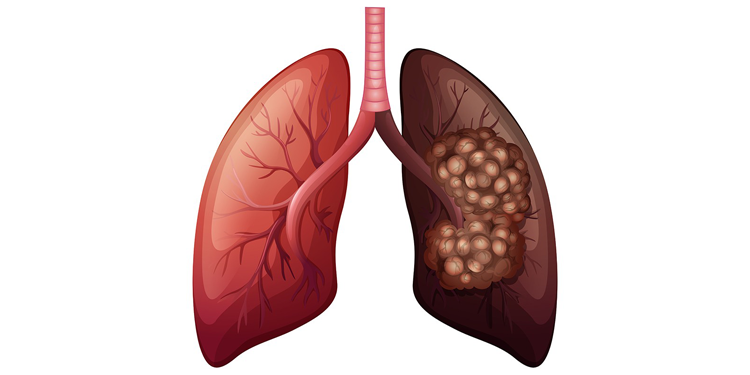Lung Cancer - Symptoms, Causes, Stages and Treatment

People who smoke have the greatest risk of lung cancer. It frequently has no evident symptoms until the disease is fairly advanced, and it has a dismal survival rate. Lung cancer treatment primarily consists of surgery and chemotherapy. Radiation therapy and targeted medication therapies are further options.
What is lung cancer?Lung cancer is caused by aberrant cell growth in the lining of the lungs, which leads to the development of a malignant tumor.
Small-cell lung cancer (SCLC) and non-small-cell lung cancer (NSCLC) are the two most common forms of lung cancer. They differ in their appearance under a microscope, how they grow and spread to other regions of the body, and how they are treated. NSCLC accounts for around 85 percent of all lung malignancies.
Lung cancer is always fatal; at five years after diagnosis, the total survival rate is around 17%. The explanation for the low survival rate is that lung cancer spreads (metastasizes) rapidly to other places of the body relatively soon after it starts (i.e. before it is diagnosed).
CausesLung cancer symptoms vary, and warning indicators are not always visible. Some people with lung cancer have no symptoms until it is diagnosed during a routine chest x-ray or computed tomography (CT) scan.
Among those who do exhibit symptoms, the following are possible:
The stage of lung cancer relates to how far cancer has gone throughout the body. Staging aids in determining how to treat cancer. Although lung cancer can spread to any organ, the liver, brain, and bones are the most commonly affected. Lung cancer is staged differently in the two types.
Non-small-cell lung cancer (NSCLC)Cancer treatment consists of surgery to remove cancer cells and chemotherapy and radiation therapy to kill cancer cells. Lung cancer is incurable unless the tumor cells are completely removed surgically.
SurgerySurgery is the most effective treatment for lung cancer, although it is only available for tumors that have not gone beyond the lungs, such as stage I, II, and III NSCLC, as well as in some individuals with restricted stage NSCLC.
Radiation treatmentRadiation therapy, which employs high-powered radiation beams to kill cancer cells, has the potential to be employed for both NSCLC and SCLC. The goal is to eliminate cancer cells while avoiding causing too much damage to normal cells. Radiation therapy is an excellent alternative for patients who are unable to undergo surgery. It can also be administered after surgery to eliminate any remaining cancer cells.
ChemotherapyChemotherapy medications are used to kill rapidly developing cancer cells in both NSCLC and SCLC. Chemotherapy medications can be administered alone or in conjunction with surgery or radiation therapy. Chemotherapy is the first-line treatment for SCLC since it has frequently spread throughout the body by the time it is detected.
Targeted therapyNormal cells are considerably less harmed by molecular-targeted therapies than by chemotherapy or radiation therapy. Tyrosine kinase inhibitors are small-molecule medicines that function inside cancer cells to prevent cancer cells from growing and dividing.
Monoclonal antibodies are immune system proteins created by humans that inhibit cancer growth and spread by interfering with specific molecules involved in tumor growth and progression.
Some molecular-targeted medication therapies are only effective if a person's cancer cells contain specific genetic alterations. There is laboratory mutation testing available to establish whether a molecular-targeted therapy medicine will work in a certain person.
Prevention